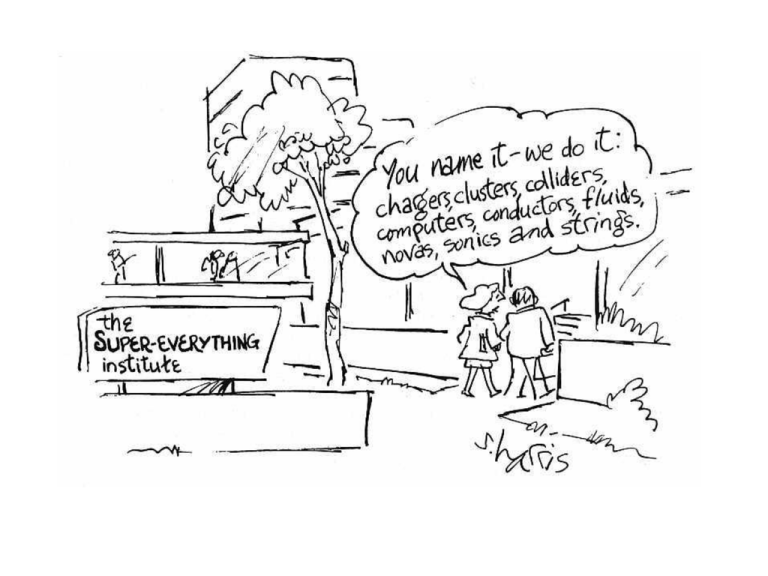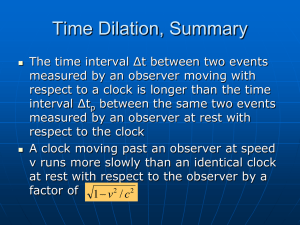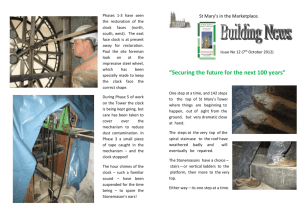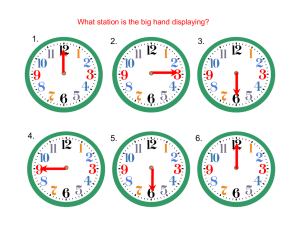Document 14306124
advertisement

Experimental Verification of Special Relativity (from Marion, Ch. 14!) • Brief discussion! • Explains all difficulties with optics & E&M that existed before 1900: Problems with the Michelson-Morley Experiment on the detection of ether went away. • What about length contraction & time dilation? These are verified on essentially a daily basis at particle accelerators where particles are accelerated to speeds v very close to the light speed c. • Consider the muon. When cosmic rays enter the Earth’s atmosphere, they interact (scatter, etc.) with particles & create “cosmic showers”. Many particles in these showers are πmesons. These decay into other particles called muons. • Muons are unstable & they decay according to the radioactive decay formula: N = N0exp[-0.693 t(t½)-1] (1) t½ Muon half-life. In the muon rest frame t½ 1.52 10-6 s Muons reach Earth’s surface & can easily be detected. • Assume a detector is at height h = 2,000 m on a mountain. Count the number of muons moving with speed v = 0.98c. Suppose find (for example) 1000 muons in a given time T. • Now, move to sea level. How many muons will we detect in the same time T? Use (1) and classical mechanics: Each muon takes a time t = h/v longer to get to detector. From (1), expect 45 muons to be detected in time T. Experiment actually gives 542 muons! N = N0exp[-0.693 t(t½)-1] (1) t½ Muon half-life. In the muon rest frame t½ 1.52 10-6 s • Do the calculation again with special relativity. Decaying muons are moving at high speeds v = 0.98c with respect to the detector. The “internal clock” of the muon experiences time dilation! In the extra time t (in the detector frame) to go from h = 2,000 m to 0, according to the muon, a time of only t´ = tγ-1 = t[1 - β2]½ = t[1 - v2c-2]½ βt will have passed. It is t´= βt which should be used in (1), not the lab time t! When we do this, we predict, in the detection time T, 538 muons should be detected. This is close to the 542 actually detected! Atomic clock time measurements • 1972: J. C. Hafele & R.E. Keating performed a direct test of relativity (actually need both special & general). Side remark: Hafele was a faculty member at Washington University, St. Louis, Missouri, when I was a graduate student there. I heard him give a colloquium on this. He didn’t get tenure! • They used 4 extremely accurate cesium atomic clocks. 2 clocks were flown on regularly scheduled commercial jet flights around the world. One flew East & the other West. The other 2, the reference clocks, stayed on Earth at U.S. Naval Observatory in D.C. • Cesium clock: Relies on a well-defined, hyperfine transition to the ground state of the 133Cs nucleus at a frequency f = 9,192,631,770 Hz. Used as a time standard for the world! • The time measured on the 2 moving clocks was compared to the time measured on the reference clocks. Eastward trip took 65.7 hours, with 41.2 flight hours. Westward trip (1 week later) took 80.3 hours with 48.6 flight hours. • Actual Predictions: Complicated by the rotation of the Earth (recall our non-inertial frame discussion) & by the gravitational attraction of Earth: Should use General Relativity instead of Special Relativity. • To understand some of this, neglect corrections due to rotation & gravitational effects. Use Special Relativity. • The Earth’s circumference C 4 107 m. A typical jet speed v 300 m/s (VERY SMALL on the scale of relativistic effects!). For one complete trip, the clock on Earth should measure a time: T0 = (C/v) 1.33 105 s ( 37 hours) • Clock on Earth: T0 = (C/v) 1.33 105 s ( 37 hours) • The moving clock should experience a time dilation & run more slowly. It should measure: T = T0γ-1 = T0[1 - β2]½ = T0[1 - v2c-2]½ The time difference between the clock on Earth & the moving clock should be: ΔT = T0 - T = T0(1 - [1 - β2]½). • Now, since v 300 m/s << c , β2 = v2c-2 <<1 Expand the square root & keep the lowest order term: ΔT = T0(1 - [1 - β2]½) (½)β2T0 • Putting in numbers: ΔT = 6.65 10-8 s = 66.5 ns! • ΔT is small, but the Cs atomic clock is so precise, ΔT >> the expected experimental uncertainty in the measurement! • Actual predictions & actual measurements are in the table: • Negative signs: The time on the moving clock is less than that on the Earth reference clock. The moving clock ran slower (lost time) on the Eastward trip & ran faster (gained time) on the Westward trip. This difference & the difference between this & the simple calculation: Due to the Earth’s rotation effects. Also, the actual calculations used General Relativity & included the effects of Earth’s gravity. Length Contraction • Thin object, moving with v || to x in S. S´ is attached to object. Instantaneous measurement of length: L´ = γL or L = γ-1L´ < L´ Lorentz-Fitzgerald Length Contraction • An Interesting consequence (from Marion). Not CORRECTLY understood until 1959! Consider a cube of side moving with constant velocity v with respect to an observer in lab frame S. The figure shows a projection of the cube on the plane containing v & observer. The figure is looking DOWN on the plane! Length Contraction: L = γ-1 L´ • Moves with side AB to observer’s line of sight. What does the observer “see”? That is, at a given instant in S, what are the relative orientations of the corners A,B,C, D? • Traditional view (unquestioned 1905-1959!): The only effect is a length contraction of the sides AB & CD such that an observer sees a distorted cube of height & shortened length γ-1 = [1 - β2]½ = [1 - v2c-2]½. Terrell (1959) showed that this overlooks the facts: Light from corners A & D reaches the observer at the same instant. Also, light from D must travel a distance farther than that from A It must have been emitted when D was at position E. Length DE = vtDE= vc-1 = β • Therefore, the observer sees face AB ( line of sight) shortened in length as γ-1 = [1 - β2]½. ALSO sees face AD (|| line of sight!). It is as if the cube is ROTATED as shown in figure: Projection of face AD line of sight is of length β. An apparent rotation of the cube through the angle sin-1(β)!!! • Can also show (contrary to what was thought until 1959) that a sphere has no distortion. • Computer generated image showing effects as just discussed: Twin “Paradox” • Interesting to discuss, but not really a paradox. • Consider twins who choose different career paths. Mary becomes an astronaut. Frank becomes a stock broker. • At age 30, Mary leaves on a mission to a planet in a nearby star’s system. She has to travel at very high speed to get there & return. According to Frank, Mary’s biological clock (t´) will “tick” more slowly than his (t) during the trip, so she should age more slowly. On the basis of time dilation, t´ = tγ-1 = t[1 - β2]½ = t[1 - v2c-2]½ He expects her to look younger than he does when she returns (it takes several years!) • The paradox, however, is that according to Mary, Frank will appear to be moving rapidly with respect to her system, so she expects that HE will be younger than her when she returns. • Which twin Mary (the moving twin) or Frank (the fixed twin) is younger on her return (or, perhaps neither!)? • Correct answer: Mary will return (biologically) younger than Frank. • Correct analysis: Suppose Mary’s ship blasts off & quickly reaches a coasting speed of v = 0.8c. Suppose she travels 8 light years to the planet & decelerates for a short visit. Assume acceleration & deceleration times at the Earth & the planet are small compared to the travel time. Total travel time to Planet = 10 years. Total return time = 10 years. On her return, Frank is 30 + 10 + 10 = 50 years old • Using time dilation, Frank calculates that Mary’s clock slows down: t´ = tγ-1 = t[1 - β2]½ = t[1 - v2c-2]½ According to her clock, each leg of the trip should take: t´ = 10 [1 - (.8)2]½ = 6 years. Biologically, Mary will thus be 30 + 6 + 6 = 42 years old on her return; 8 years younger than her twin! • Note that Frank’s clock is in an inertial frame & Mary’s is not because of the acceleration & deceleration she experiences on take off & landing. To compute her time passage & compare to Franks’ SHE shouldn’t use the above formula!




